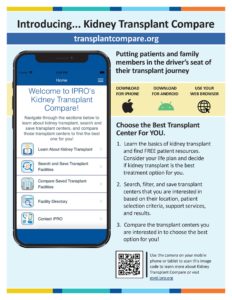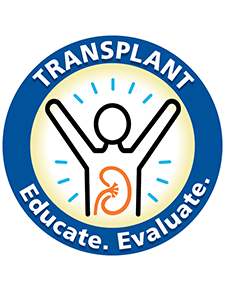Improving Transplant Coordination
The ESRD Network program supports the national focus to improve transplant coordination. Our goal is to improve kidney health by having at least 80 percent of new ESRD patients either receiving dialysis at home or a kidney transplant by the year 2025. Our Networks work with dialysis facilities to enact this change. By collaborating with transplant centers and dialysis facilities, our Networks will establish interventions that will aid in overcoming barriers and improve communication.
Scroll down to view our listing of provider and patient resources.
Tools & Resources for Providers
Below are tools and resources that providers can use to increase patient interest, knowledge, and access to kidney transplant as well as improve facility process to ensure success with the CMS ESRD goals. Below the link is a description on how to use the resource and guidance on which barriers they help to overcome.
General Transplant Quality Improvement Resources
- How CMS Goals, Payment Models, and Quality Incentive Plans Align to Promote Transplant and Home
- This flyer provides education to care providers about the current initiatives and policies in place that are driving transplant and home efforts.
- Transplant Root Cause Analysis Facility Action Guide
- This resource is designed to be used during the RCA phase of the quality improvement cycle to help pinpoint the greatest barrier to improving waitlisting and transplant rates at your facility.
- New York Only: New Law Expands Your Options for a Lifesaving Transplant
- A new state law known as the HEART Act (Helping Equal Access to Registration for Transplant), now lets patients join the waitlist at more than one transplant center in New York State.
Tools to Run an Effective Quality Improvement Project
Root Cause Analysis (RCA)
-
- A root cause analysis is the process of discovering the reason or cause of a problem to identify an appropriate solution. To improve transplant rates, your root cause will be the barrier that is preventing your facility from finding greater success with waitlist and transplant rates. View this video or read this guide to learn how to conduct a root cause analysis (RCA).
Plan-Do-Study-Act (PDSA)
-
- Once you identify your root cause or barrier, you will then run a PDSA cycle. Running a PDSA cycle means you will plan out a test of change, carry out the test, observe, analyze, and determine if the change was successful, and then put the change into action or not. Utilize these worksheets to guide you through a PDSA cycle
Resources for Specific Barriers
Kidney Transplant Compare: Flyer|Website
- Barrier: Medical Ineligibility, patient interest, age, provider education, transplant center communication
- This desktop and mobile application allow providers and patients to navigate kidney transplant education as well as search and compare transplant centers by their location, medical selection criteria, and support services. Information available on this application can allow providers to help patient find a transplant center that is right for them.
Reduce Weight-Related Medical Ineligibility for Transplant: A Change Packet Approach
- Barrier: Medical ineligibility
- Change packet that identifies facility change practices and mitigation strategies to medical ineligibility related to patient body weight. Use this change package to identify a new approach to overcoming this barrier, to include revamping diet and exercise education and considering alternative approaches such as bariatric surgery referral and weight-loss medication.
Maintain Your Patient’s Active Status on the Transplant Wait List
- Barrier: Remaining Active on Waitlist
- This frequently asked questions and best practices guide offers provider education on the monthly blood samples required while a patient is on the waitlist and a 4-step best practice guide that you can implement at your facility today
Tips for Positive Transplant Referral Outcomes
- Barrier: Referral to Waitlist Process
- The 1-page frequently asked questions guide was made alongside transplant centers to aid dialysis facility staff in improving referral practices.
Help Your Patients Reduce the Wait for a Kidney Transplant
- Barrier: Patient age, Patient interest due to wait time, staff education about transplant
- This resource was developed to familiarize providers on how they can assist their patients reduce their wait time on the deceased donation waitlist.
- Barrier: Medical and non-medical ineligibility
- This tool allows the provider to assist the patient in following an algorithm to go from ineligible to eligible for a kidney transplant. This tool addresses conditions such as cancer and cardiac illness as well as patient noncompliance, elevated BMI, and lack of patient support
Newly Transplanted Celebration Poster
- Barrier: Patient interest, facility culture
- This poster allows the dialysis facility to showcase and celebrate patients who have received a kidney transplant. Utilize this poster in a way that is compliant with your facility policy and ensure patients sign a disclosure form before sharing any of their information.
- Barrier: Provider education, Transplant Center Knowledge, Transplant Center Communication, Referral to Waitlist Process, Staff Education about transplant, facility culture
- View the transplant center spotlight series by state to learn how to be successful with waitlist and transplant from the transplant centers
Tools & Resources for Patients
A kidney transplant is a type of surgery where you (the recipient) gets a kidney that was donated by someone else (the donor). This treatment option offers better quality of life and increased health compared to other treatment options. Below are tools and resources that patients can use to increase interest, knowledge, and access to kidney transplant. The resources are listed based on the Five Steps Towards Kidney Transplant.
Five Steps Towards Transplant
- Interest in Transplantation
- Patient Educational Videos about Transplant: Website
- Do You Know Your Treatment Options Brochure: English|Spanish
2. Referral to Transplant
Kidney Transplant Compare: Flyer|Website
- This desktop and mobile application allow patients to find kidney transplant education as well as search and compare transplant centers by their location, medical selection criteria, and support services. Information available on this application can allow you as a patient find the transplant center that is best for you.
3. Transplant Evaluation
- Waitlist and Living Donation


